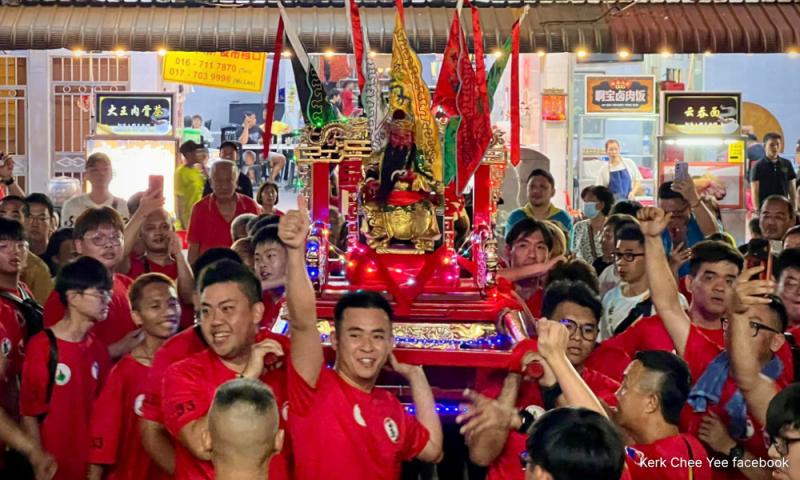
KINIGUIDE | 'Flag war' over Guan Gong Festival
Cha Zhi Ting
Published: Nov 1, 2024 9:25 PM
KINIGUIDE | Last week, Perak PAS leader Razman Zakaria took DAP leaders Nga Kor Ming and Woo Kah Leong to task for an alleged incident in Teluk Intan where China’s national flag was flown during a procession.
It later emerged that the controversy was centred around the Malaysian leg of the International Guan Gong Cultural Festival, and the people seen waving the Chinese flag were members of a delegation from China.
This week, another parade linked to the festival, this time in Johor, also ran into problems and is now facing a police investigation.
What exactly is the International Guan Gong Cultural Festival, and why are the police investigating it? This instalment of KiniGuide seeks to explain the story behind the controversy.
Who is ‘Guan Gong’?
Guan Yu was a general during the late-Han and Three Kingdoms period in China, which was around the third century.
Over the centuries since his death, he has become deified and worshipped as Guan Gong (meaning “Lord Guan”) – the god of war, protection from evil, and loyalty. He is worshipped by adherents of Taoism, Confucianism, and Chinese Buddhism.
He is commonly depicted with reddish skin and a long, dark beard, often wearing armour (or green robes with armour underneath) while holding a glaive as his signature weapon.
His exploits were novelised in the 14th-century Chinese classic “Romance of the Three Kingdoms” and dramatised in Chinese operas based on the novel.
In modern popular culture, Guan Yu is a prominent character in many video games and movies featuring the Three Kingdoms period, such as the long-running “Dynasty Warriors” series of fighting games, the strategy game “Total War: Three Kingdoms”, the 2008 film “Red Cliff”, and the 2011 film “The Lost Bladesman” that starred Hong Kong actor Donnie Yen as Guan Yu.

The deity Guan Gong
What is the Guan Gong Cultural Festival?
The inaugural Guan Gong Cultural Festival was held in 2015.
This year’s festivities mark its 10th year with the theme “10th Malaysia International Guan Gong Cultural Festival”.
According to former Sungai Pelek assemblyperson and Guan Gong Cultural Association chief adviser Ronnie Liu, the festival’s purpose is to promote the spirit of Guan Yu, such as loyalty, righteousness, benevolence, wisdom, and courage.
The festival also aims to promote moral values among the public, improve societal ethics, and promote Guan Gong culture internationally.
Who are the organisers?
The main organiser of the Guan Gong Cultural Festival in Malaysia is the Malaysia Guan Gong Cultural Association, which not only seeks to promote values embodied by Guan Gong but also foster relations among Southeast Asian Chinese on Guan Gong worship and cultivate a positive societal atmosphere.
The association was established in 2015, with Soon Boon Hua serving as its president.

What is the Guan Gong Cultural Festival?
The inaugural Guan Gong Cultural Festival was held in 2015.
This year’s festivities mark its 10th year with the theme “10th Malaysia International Guan Gong Cultural Festival”.
According to former Sungai Pelek assemblyperson and Guan Gong Cultural Association chief adviser Ronnie Liu, the festival’s purpose is to promote the spirit of Guan Yu, such as loyalty, righteousness, benevolence, wisdom, and courage.
The festival also aims to promote moral values among the public, improve societal ethics, and promote Guan Gong culture internationally.
Who are the organisers?
The main organiser of the Guan Gong Cultural Festival in Malaysia is the Malaysia Guan Gong Cultural Association, which not only seeks to promote values embodied by Guan Gong but also foster relations among Southeast Asian Chinese on Guan Gong worship and cultivate a positive societal atmosphere.
The association was established in 2015, with Soon Boon Hua serving as its president.

Malaysia Guan Gong Cultural Association president Soon Boon Hua
Its members include individuals with political backgrounds.
Soon is a former MCA leader who left the party in July 2014, while Liu is a former Selangor state executive councillor who left DAP in June 2023. Another adviser, Chiew Lian Keng, once served as Federal Territories MCA Youth chief.
Perak state executive councillor Woo and Ayer Keroh assemblyperson Kerk Chee Yee are advisers to the festival’s organising committee.
What activities are part of the Guan Gong Cultural Festival?
In previous years, the International Guan Gong Cultural Festival featured a relay of Guan Gong statues between participating countries.
Local organisations also hosted related events such as networking dinners, worshipping ceremonies, and parades with the statue.
This year, a torch relay event called “The Fire of Loyalty and Righteousness Spreads to Nanyang” has been introduced. Nanyang (meaning “Southern Ocean”) is an archaic term generally referring to Southeast Asia.
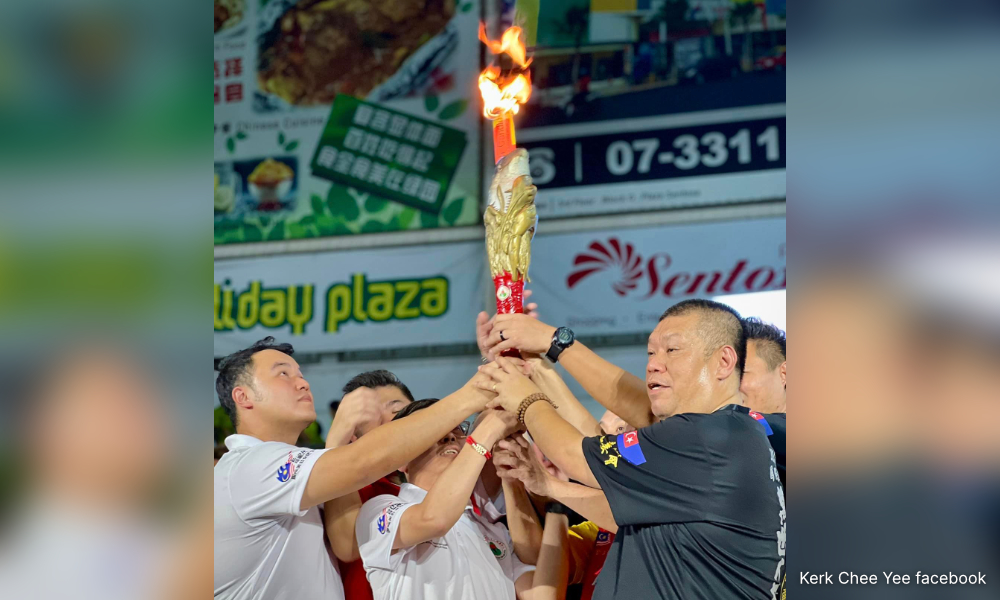
Soon is a former MCA leader who left the party in July 2014, while Liu is a former Selangor state executive councillor who left DAP in June 2023. Another adviser, Chiew Lian Keng, once served as Federal Territories MCA Youth chief.
Perak state executive councillor Woo and Ayer Keroh assemblyperson Kerk Chee Yee are advisers to the festival’s organising committee.
What activities are part of the Guan Gong Cultural Festival?
In previous years, the International Guan Gong Cultural Festival featured a relay of Guan Gong statues between participating countries.
Local organisations also hosted related events such as networking dinners, worshipping ceremonies, and parades with the statue.
This year, a torch relay event called “The Fire of Loyalty and Righteousness Spreads to Nanyang” has been introduced. Nanyang (meaning “Southern Ocean”) is an archaic term generally referring to Southeast Asia.

A torch relay is
introduced in this year’s edition of the International Guan Gong Cultural Festival
The torch relay began on June 6 from Guan Yu’s hometown in Shanxi province, China, passing through Taiwan (June 19), Hong Kong (July 18), Macau (July 21), the Philippines (July 23), Japan (July 27), Vietnam (Aug 1), Laos (Aug 17), Thailand (Aug 21), Indonesia (Aug 26), and Singapore (Aug 30), before reaching Malaysia on Sept 1. The Guan Gong statues accompanied the torch along this route.
After arriving in Malaysia, the torch and statues travelled from north to south, starting in Kedah and Perlis (Sept 16-17) and proceeding to Penang (Sept 18-19), Perak (Sept 20-21), Selangor and Kuala Lumpur (Sept 22-24), Negeri Sembilan (Sept 25), Malacca (Sept 26), and Johor (Sept 27-28).
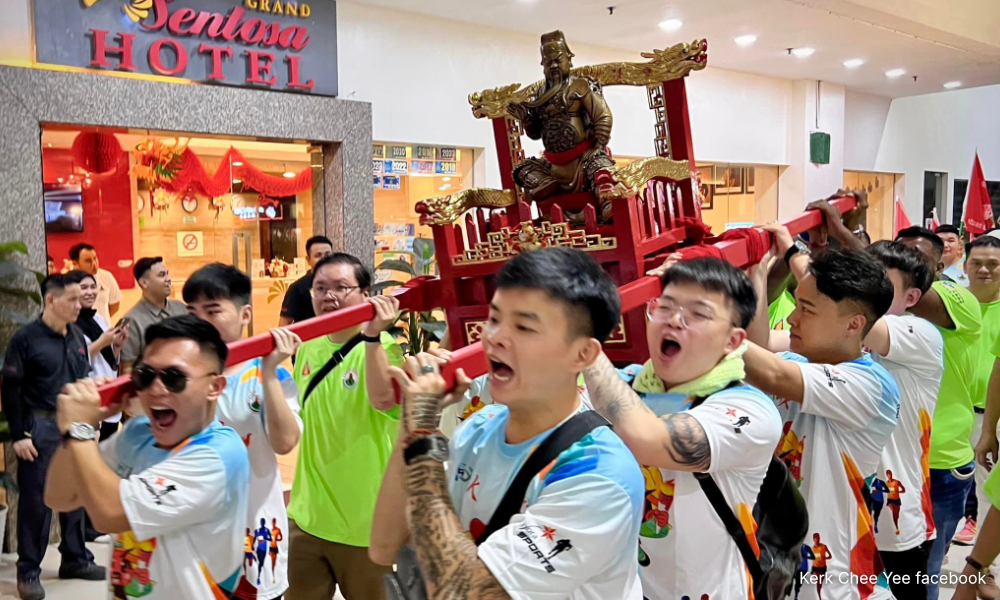
After arriving in Malaysia, the torch and statues travelled from north to south, starting in Kedah and Perlis (Sept 16-17) and proceeding to Penang (Sept 18-19), Perak (Sept 20-21), Selangor and Kuala Lumpur (Sept 22-24), Negeri Sembilan (Sept 25), Malacca (Sept 26), and Johor (Sept 27-28).

Relay of Guan Gong statues arriving in Johor Bahru
The cultural festival activities began in Singapore on Oct 17, travelling northwards to Thailand. Key locations included Johor (Oct 18-20), Malacca (Oct 21), Negeri Sembilan (Oct 22), Selangor (Oct 23), Perak (Oct 24-25), Kuala Lumpur (Oct 26-27), Kedah and Perlis (Oct 28), Penang (Oct 29), and Thailand (Oct 30-Nov 3).
During these events, the torch and statues would move from Johor to each venue. The torch would remain in Penang, while the statues continued to Thailand and returned to China after the events.
The “10th Malaysia International Guan Gong Cultural Festival” parade was held at three locations: Johor Bahru, Kuala Lumpur, and Teluk Intan in Perak.
How did the event become controversial?
The issue stemmed from festival participants who were seen waving the China flag during the parades in Teluk Intan and Johor Bahru.
Perak PAS commissioner Razman argued that waving the Chinese flag on the streets could be seen as a provocative challenge against Malaysia’s sovereignty and harmony, and called for an investigation against Nga and Woo.
Razman, who is also the Gunung Semanggol assemblyperson, is believed to be targeting Nga and Woo because some banners at the event featured photos of the duo.
Nga happens to be Teluk Intan MP, while Woo’s office is the patron of the Perak segment of the Guan Gong Cultural Festival.
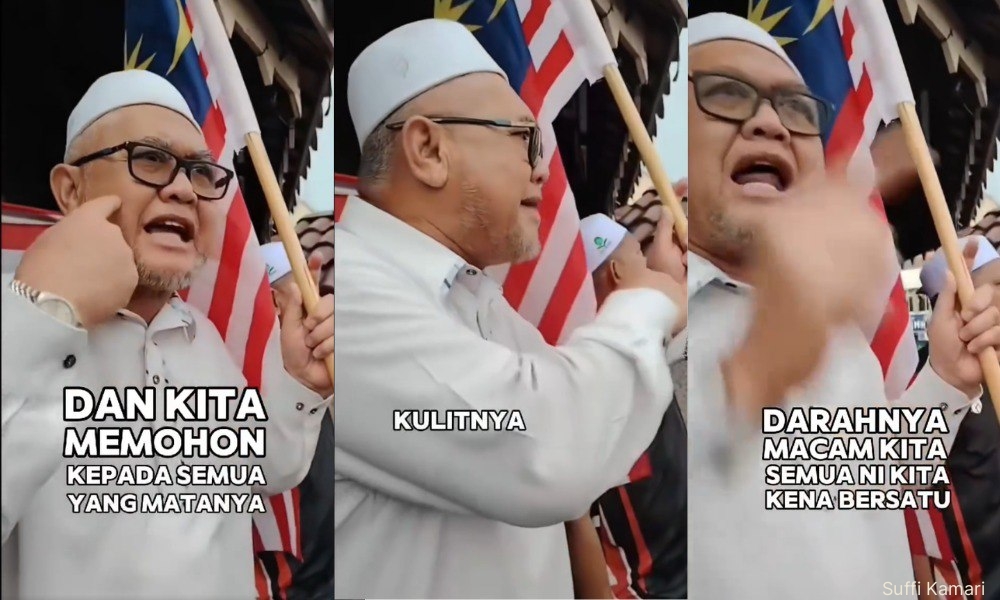
During these events, the torch and statues would move from Johor to each venue. The torch would remain in Penang, while the statues continued to Thailand and returned to China after the events.
The “10th Malaysia International Guan Gong Cultural Festival” parade was held at three locations: Johor Bahru, Kuala Lumpur, and Teluk Intan in Perak.
How did the event become controversial?
The issue stemmed from festival participants who were seen waving the China flag during the parades in Teluk Intan and Johor Bahru.
Perak PAS commissioner Razman argued that waving the Chinese flag on the streets could be seen as a provocative challenge against Malaysia’s sovereignty and harmony, and called for an investigation against Nga and Woo.
Razman, who is also the Gunung Semanggol assemblyperson, is believed to be targeting Nga and Woo because some banners at the event featured photos of the duo.
Nga happens to be Teluk Intan MP, while Woo’s office is the patron of the Perak segment of the Guan Gong Cultural Festival.

Screenshots from a video showing Perak PAS commissioner Razman Zakaria’s speech at the counter-rally at Menara Condong Teluk Intan on Oct 26, 2024.
Woo’s political secretary, Koh Ling Xian, told Malaysiakini that the Guan Gong Cultural Festival activities nationwide have received support from the Tourism, Arts, and Culture Ministry.
However, in his statement on Oct 25, Razman mistakenly linked the flag-waving incident to a Mid-Autumn Festival event in Teluk Intan on Sept 13, when it took place during the Guan Gong Cultural Festival parade on Oct 24.
In protest of the flag-waving incident, Razman held a counter rally near Menara Condong Teluk Intan on Oct 26, where he stirred further controversy by making a call for unity that used physical features as a reference point.
“We ask those whose eyes are like this (while pointing to his eyes), skin like this (while pointing to his skin), and blood like ours, we must unite, this is the struggle we champion,” he said.
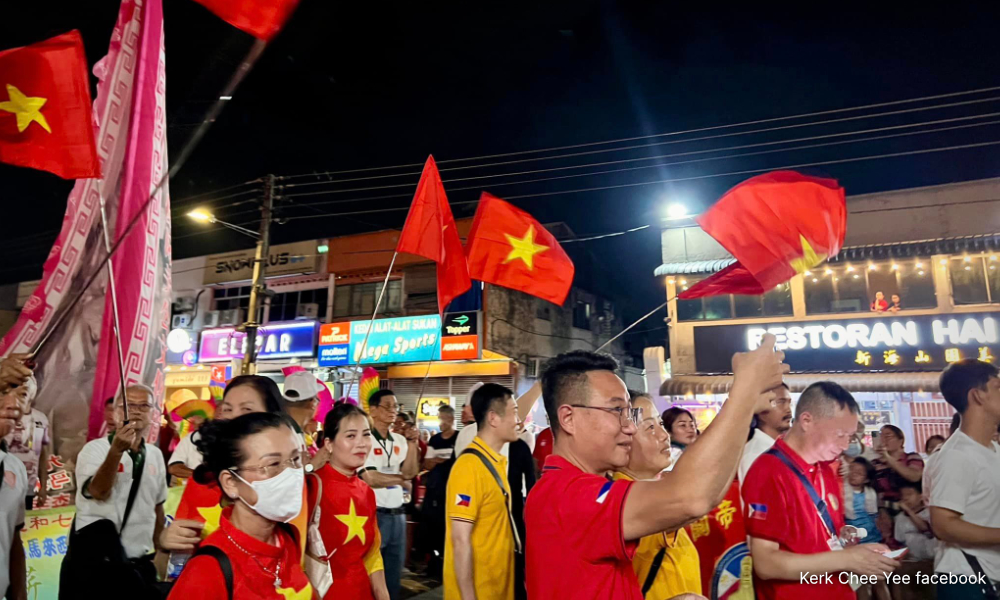
Woo’s political secretary, Koh Ling Xian, told Malaysiakini that the Guan Gong Cultural Festival activities nationwide have received support from the Tourism, Arts, and Culture Ministry.
However, in his statement on Oct 25, Razman mistakenly linked the flag-waving incident to a Mid-Autumn Festival event in Teluk Intan on Sept 13, when it took place during the Guan Gong Cultural Festival parade on Oct 24.
In protest of the flag-waving incident, Razman held a counter rally near Menara Condong Teluk Intan on Oct 26, where he stirred further controversy by making a call for unity that used physical features as a reference point.
“We ask those whose eyes are like this (while pointing to his eyes), skin like this (while pointing to his skin), and blood like ours, we must unite, this is the struggle we champion,” he said.

Vietnamese participants at the Guan Gong Cultural Festival parade in Johor Bharu on Oct 20
This week, Perikatan Nasional revisited the issue by bringing up an earlier parade in Johor Bahru on Oct 20 and linking it to Kerk.
Both Kerk and the association clarified that at both parades, delegates from each country carried their respective national flags, and the Malaysian flag was also present at the event.
Liu told Malaysiakini that representatives from each country brought their own flags to the Guan Gong Cultural Festival for identification purposes.
The Kuala Lumpur parade took place as scheduled on Oct 26, and no incidents were reported.
What is being investigated?
There are currently at least four criminal cases under investigation, two of which involve the Guan Gong Cultural Festival parades in Teluk Intan and Johor Bahru.
The Perak police are investigating the Teluk Intan “Chinese flag-waving” incident under Section 3(1) of the National Emblems (Control of Display) Act 1949 and Section 4(1) of the Peaceful Assembly Act 2012.
The case has since been handed over to Bukit Aman for further action.
Meanwhile, Johor police are investigating the Johor Bahru parade under Section 3(1) of the National Emblems (Control of Display) Act, Section 505(b) of the Penal Code (public mischief), and Section 233 of the Communications and Multimedia Act 1998 (abuse of network facilities).
The National Emblems (Control of Display) Act criminalises the display of any foreign national emblem (such as a flag) in public or at schools - except for diplomatic representatives and on ships and aircraft - unless they have written permission from a minister in the Prime Minister’s Department.
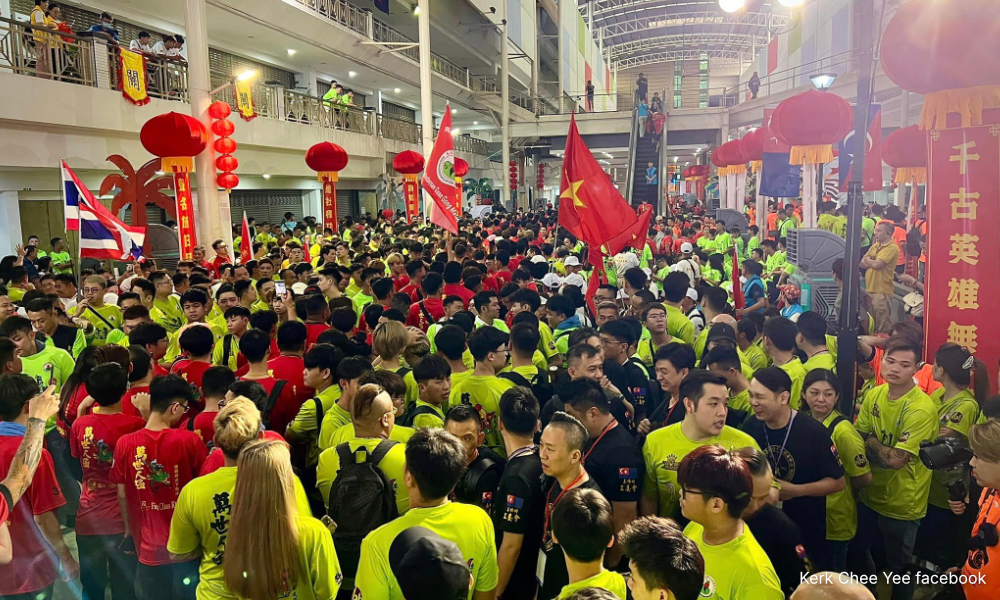
According to Soon, 17 participants from China have provided statements to the police, and he had also been questioned.
The other two criminal cases involve Razman.
One case stems from Razman’s accusations linking Nga and Woo to the display of Chinese flags, which led to an investigation by the police and the Communications and Multimedia Commission.
The other case is on Razman’s involvement in the counter rally on Oct 26, which is being investigated under the Peaceful Assembly Act.
Both Kerk and the association clarified that at both parades, delegates from each country carried their respective national flags, and the Malaysian flag was also present at the event.
Liu told Malaysiakini that representatives from each country brought their own flags to the Guan Gong Cultural Festival for identification purposes.
The Kuala Lumpur parade took place as scheduled on Oct 26, and no incidents were reported.
What is being investigated?
There are currently at least four criminal cases under investigation, two of which involve the Guan Gong Cultural Festival parades in Teluk Intan and Johor Bahru.
The Perak police are investigating the Teluk Intan “Chinese flag-waving” incident under Section 3(1) of the National Emblems (Control of Display) Act 1949 and Section 4(1) of the Peaceful Assembly Act 2012.
The case has since been handed over to Bukit Aman for further action.
Meanwhile, Johor police are investigating the Johor Bahru parade under Section 3(1) of the National Emblems (Control of Display) Act, Section 505(b) of the Penal Code (public mischief), and Section 233 of the Communications and Multimedia Act 1998 (abuse of network facilities).
The National Emblems (Control of Display) Act criminalises the display of any foreign national emblem (such as a flag) in public or at schools - except for diplomatic representatives and on ships and aircraft - unless they have written permission from a minister in the Prime Minister’s Department.

According to Soon, 17 participants from China have provided statements to the police, and he had also been questioned.
The other two criminal cases involve Razman.
One case stems from Razman’s accusations linking Nga and Woo to the display of Chinese flags, which led to an investigation by the police and the Communications and Multimedia Commission.
The other case is on Razman’s involvement in the counter rally on Oct 26, which is being investigated under the Peaceful Assembly Act.
What ostensibly began as a celebration of ethnic Chinese cultural history and Taoist religious faith appears to have been hijacked to be an exercise promoting support for the Chinese Communist party.
ReplyDeleteHijacked?
DeleteBy whom, mfer?
Oooop… a bananized u & yr pact of inferiorized xenophobic ketuanan dickheads!
起来Qǐlái!! 起来Qǐlái!! 起来Qǐlái!!
ReplyDelete